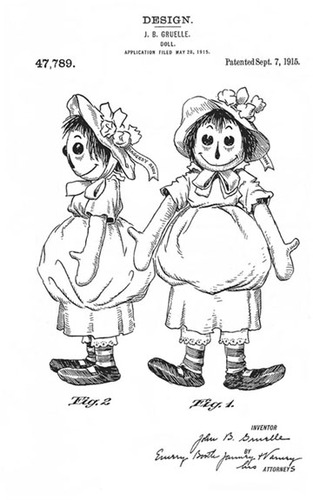|
Raggedy Ann And Raggedy Andy (1941 Film)
''Raggedy Ann and Raggedy Andy'' is a two-reel cartoon produced by Fleischer Studios and released on April 11, 1941. It was co-written by Johnny Gruelle's son, Worth. It was the first Paramount cartoon to feature Raggedy Ann. This cartoon marks the only appearances of her brother Raggedy Andy and The Camel with the Wrinkled Knees. The cartoon depicts Raggedy Ann and Andy as sweethearts as opposed to siblings in the books. Summary The story of ''Raggedy Ann and Raggedy Andy'' begins when a little girl in a toy shop sees two rag dolls whose hands are sewn together. Because she could not afford to purchase both dolls, and because she really preferred the "beautiful girl doll", she asked the toyshop owner if he would be willing to unstitch the hands so that she could buy "the beautiful girl doll". Turning down the little girl's request, the owner explained to her the reason behind his refusal. One evening in Ragland, sentient needles, threads, scissors, paintbrushes, and other creati ... [...More Info...] [...Related Items...] OR: [Wikipedia] [Google] [Baidu] |
Dave Fleischer
Dave Fleischer (; July 14, 1894 – June 25, 1979) was an American film director and producer, best known as a co-owner of Fleischer Studios with his older brother Max Fleischer. He was a native of New York City. Biography Fleischer was the youngest of five brothers and grew up in Brownsville, Brooklyn, a poor Jewish neighbourhood. By the time he was born, his father had lost his means of livelihood due to the mass production of garments. Fleischer worked as an usher at the Palace Theatre (New York City), Palace Theater on Broadway, where he was exposed to vaudeville. This experience contributed to the development of his sense for gags and comic timing, which came into play when he joined forces with his older brother, Max in the production of animated cartoons. At one point, the family lived in Coney Island, and he became interested in being a clown for one of the sideshow amusements. This clown character would be recalled a few years later in connection with Max's early expe ... [...More Info...] [...Related Items...] OR: [Wikipedia] [Google] [Baidu] |
Raggedy Andy
Raggedy Ann is a character created by American writer Johnny Gruelle (1880–1938) that appeared in a series of books he wrote and illustrated for young children. Raggedy Ann is a rag doll with red yarn for hair and a triangle nose. Gruelle received US Patent D47789 for his Raggedy Ann doll on September 7, 1915. The character was created in 1915 as a doll, and was introduced to the public in the 1918 book ''Raggedy Ann Stories''. When a doll was marketed with the book, the concept had great success. A sequel, ''Raggedy Andy Stories'' (1920), introduced the character of her brother, Raggedy Andy. Further characters such as Beloved Belindy, a black mammy doll, were featured as dolls and characters in books. Origins The exact details of the origins of the Raggedy Ann doll and related stories, which were created by Johnny Gruelle, are not specifically known, although numerous myths and legends about the doll's origins have been widely repeated. Gruelle biographer and Raggedy Ann h ... [...More Info...] [...Related Items...] OR: [Wikipedia] [Google] [Baidu] |
Films About Dolls
A film also called a movie, motion picture, moving picture, picture, photoplay or (slang) flick is a work of visual art that simulates experiences and otherwise communicates ideas, stories, perceptions, feelings, beauty, or atmosphere through the use of moving images. These images are generally accompanied by sound and, more rarely, other sensory stimulations. The word "cinema", short for cinematography, is often used to refer to filmmaking and the film industry, and to the art form that is the result of it. Recording and transmission of film The moving images of a film are created by photographing actual scenes with a motion-picture camera, by photographing drawings or miniature models using traditional animation techniques, by means of CGI and computer animation, or by a combination of some or all of these techniques, and other visual effects. Before the introduction of digital production, series of still images were recorded on a strip of chemically sensitiz ... [...More Info...] [...Related Items...] OR: [Wikipedia] [Google] [Baidu] |
Animated Films Based On Toys
Animation is a method by which still figures are manipulated to appear as moving images. In traditional animation, images are drawn or painted by hand on transparent celluloid sheets to be photographed and exhibited on film. Today, most animations are made with computer-generated imagery (CGI). Computer animation can be very detailed 3D animation, while 2D computer animation (which may have the look of traditional animation) can be used for stylistic reasons, low bandwidth, or faster real-time renderings. Other common animation methods apply a stop motion technique to two- and three-dimensional objects like paper cutouts, puppets, or clay figures. A cartoon is an animated film, usually a short film, featuring an exaggerated visual style. The style takes inspiration from comic strips, often featuring anthropomorphic animals, superheroes, or the adventures of human protagonists. Especially with animals that form a natural predator/prey relationship (e.g. cats and mice, coyot ... [...More Info...] [...Related Items...] OR: [Wikipedia] [Google] [Baidu] |

